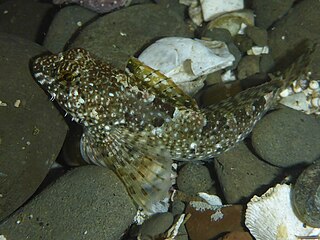
The Cottidae are a family of fish in the superfamily Cottoidea, the sculpins. It is the largest sculpin family, with about 275 species in 70 genera. They are referred to simply as cottids to avoid confusion with sculpins of other families.

The grunt sculpin or grunt-fish is a small fish mainly found in the eastern Pacific Ocean. The grunt sculpin generally remains close to shore and is often found in empty giant barnacle shells. The common name comes from reports that the fish vibrate or "grunt" when held. Its defining feature is its tendency to “hop” along the ocean floor on its orange fins. The short, stout body of the grunt sculpin has a long, small mouth which is adapted for eating smaller prey.

The fish family Psychrolutidae contains over 35 recognized species in 8 genera. This family consists of bottom-dwelling marine sculpins shaped like tadpoles, with large heads and bodies that taper back into small, flat tails. The skin is loosely attached and movable, and the layer underneath it is gelatinous. The eyes are placed high on the head, focused forward closer to the tip of the snout. Members of the family generally have large, leaf-like pectoral fins and lack scales, although some species are covered with soft spines. This is important to the species as the depths in which they live are highly pressurized and they are ambush/opportunistic/foraging predators that do not expend energy unless they are forced to.

The lingcod or ling cod, also known as the buffalo cod or cultus cod, is a fish of the greenling family Hexagrammidae. It is the only extant member of the genus Ophiodon. A slightly larger, extinct species, Ophiodon ozymandias, is known from fossils from the Late Miocene of Southern California.

The Pacific staghorn sculpin is a species of marine ray-finned fish belonging to the family Cottidae, the typical sculpins. This species is found in the eastern Pacific Ocean. It is the only species in the monospecific genus Lepidocottus.

Clinocottus is a genus of marine ray-finned fishes belonging to the family Cottidae, the typical sculpins. They are nearshore benthic fishes native to the northeastern Pacific Ocean. They are mentioned as sharpnose sculpins.

Artedius is a genus of marine ray-finned fishes belonging to the family Cottidae, the typical sculpins. These fishes are found in the northern Pacific Ocean.

The roughback sculpin is a species of marine ray-finned fish belonging to the family Cottidae, the typical sculpins. This species is found in the eastern Pacific Ocean. The roughback sculpin is the only known member of the genus Chitonotus.

Icelinusis a genus of marine ray-finned fishes belonging to the family Cottidae, the typical sculpins. These fishes are found in the northern and eastern Pacific Ocean.

The longfin sculpin is a species of marine ray-finned fish belonging to the family Jordaniidae, a small family of sculpins. This species is found in the northeastern Pacific Ocean. This species is the only known member of its genus, Jordania.

The prickly sculpin is a species of ray-finned fish belonging to the family Cottidae, the typical sculpins. It is native to the river drainages of the Pacific Slope of North America from Seward, Alaska south to the Ventura River of Southern California. It extends east of the Continental Divide in the Peace River of British Columbia. It has also been introduced to several reservoirs in Southern California.

Enophrys bison, the buffalo sculpin, is a species of marine ray-finned fish, belonging to the family Cottidae, the typical sculpins. It is found in the eastern Pacific Ocean.

Artedius corallinus, the coralline sculpin, is a species of marine ray-finned fish belonging to the family Cottidae, the typical sculpins. It is found in the eastern North Pacific along the coasts of the western United States and Baja California.

Artedius fenestralis, the padded sculpin, is a species of marine ray-finned fish belonging to the family Cottidae, the typical sculpins. The species is native to the eastern Pacific Ocean, with a range extending from the Alaska Peninsula to Southern California. It grows to a maximum length of 14 centimeters and subsists on a diet of shrimp and small fishes.

Artedius lateralis, also known as the smoothhead sculpin or round-nosed sculpin, is a species of marine ray-finned fish belonging to the family Cottidae, the typical sculpins. The species, commonly found in the intertidal zone and to depths of 43 feet, is native to the northern Pacific, from Russia and the Bering Sea to Baja California. Growing to a length of 14 centimeters, it takes its name from the lack of scales on its head.

Artedius notospilotus, or the bonehead sculpin, is a species of marine ray-finned fish belonging to the family Cottidae, the typical sculpins. Commonly found in the intertidal zone to depths of 170 feet, the species has a range extending from the Puget Sound, Washington to the Baja California peninsula. It serves as the host for Podocotyle enophrysi, a species of parasitic flatworm.

The woolly sculpin is a species of ray-finned marine fish belonging to the family Cottidae, or the typical sculpins. It is found in the eastern Pacific Ocean, where it occurs along the coastline of California south to Baja California.

The fluffy sculpin or Lizard Fish is a fish species in the sculpin family Cottidae. It inhabits the coastal northwestern Pacific Ocean, ranging from Kodiak, Alaska to Baja California (Mexico). Individuals reach up to 9 cm (3.5 in) in length, and are commonly found in tidepools, often associated with algae.

The bald sculpin is a species of marine ray-finned fish belonging to the family Cottidae, the typical sculpins. It is found in the eastern Pacific Ocean.

Cottinae is a subfamily of ray-finned fishes belonging to the family Cottidae, the typical sculpins. The subfamily has species throughout the northern hemisphere in both marine and freshwater habitats.





















